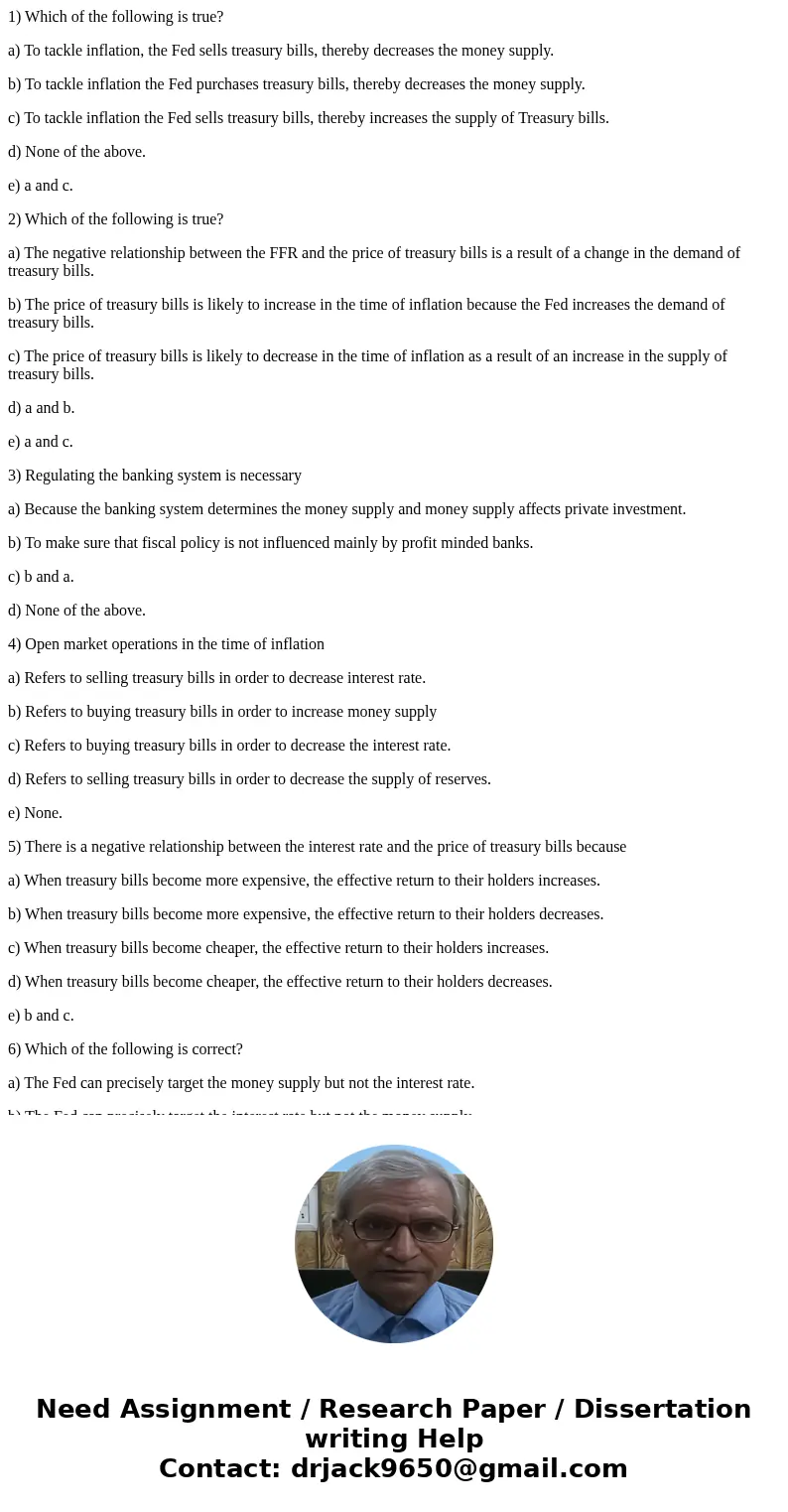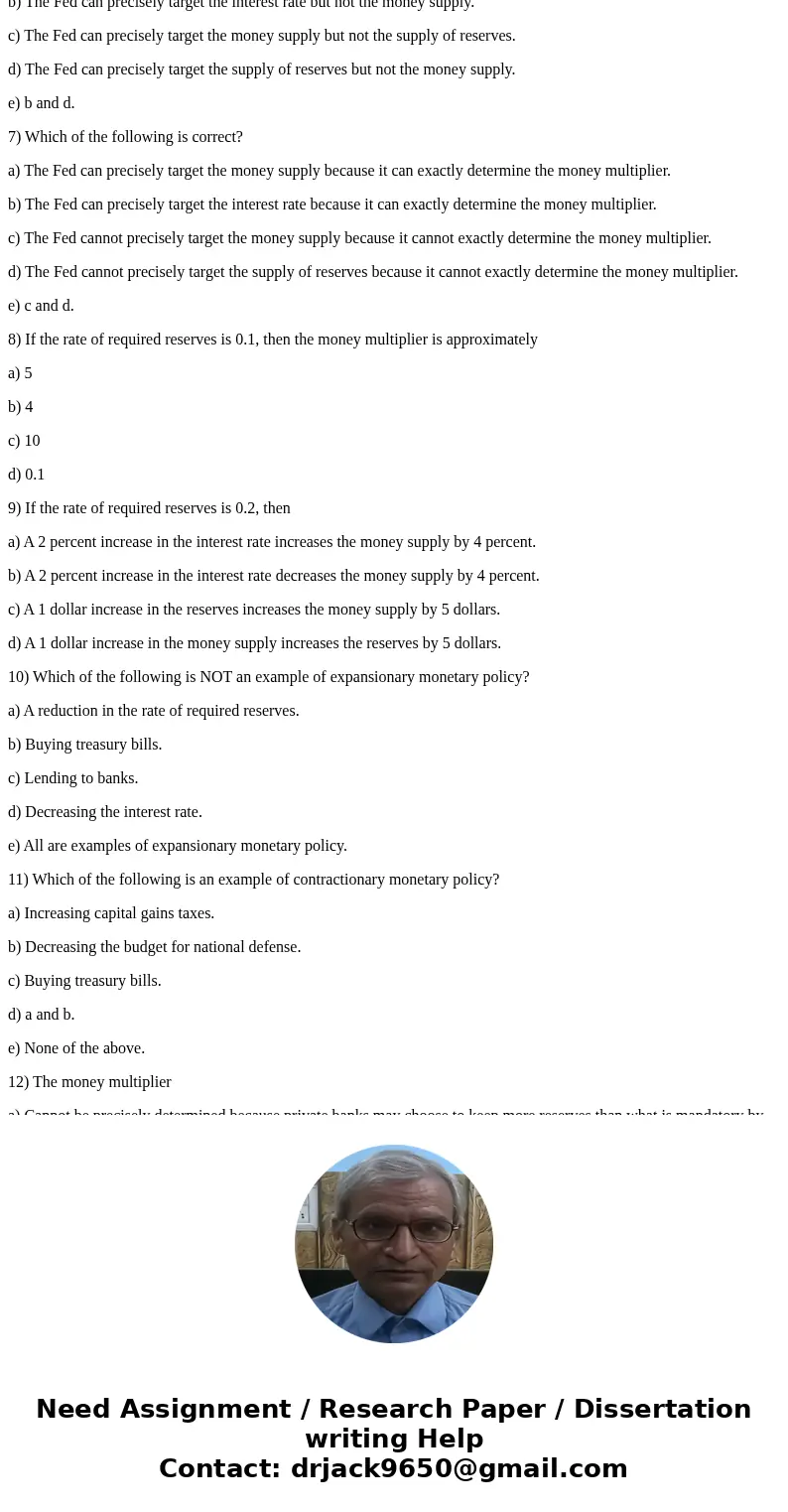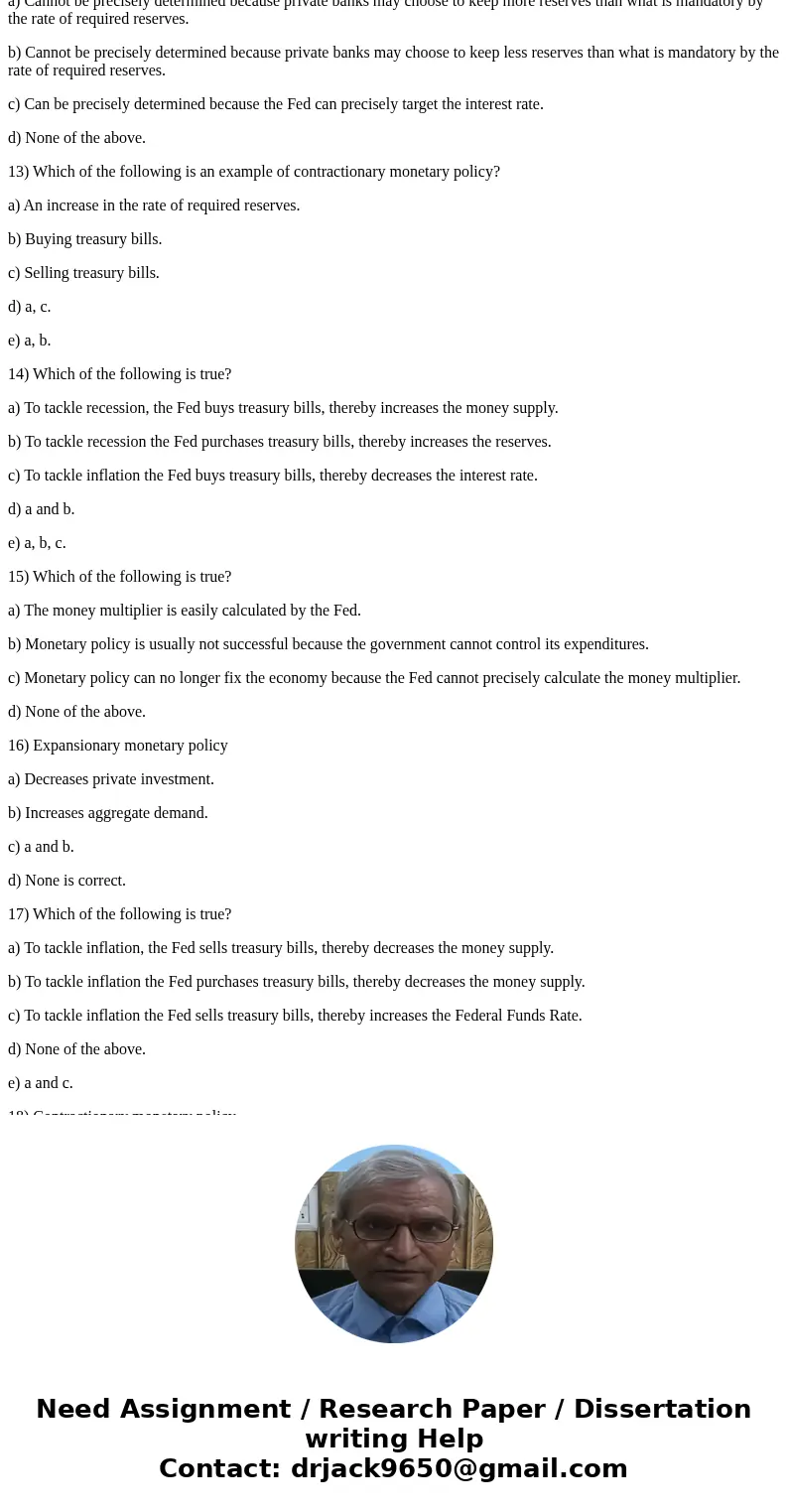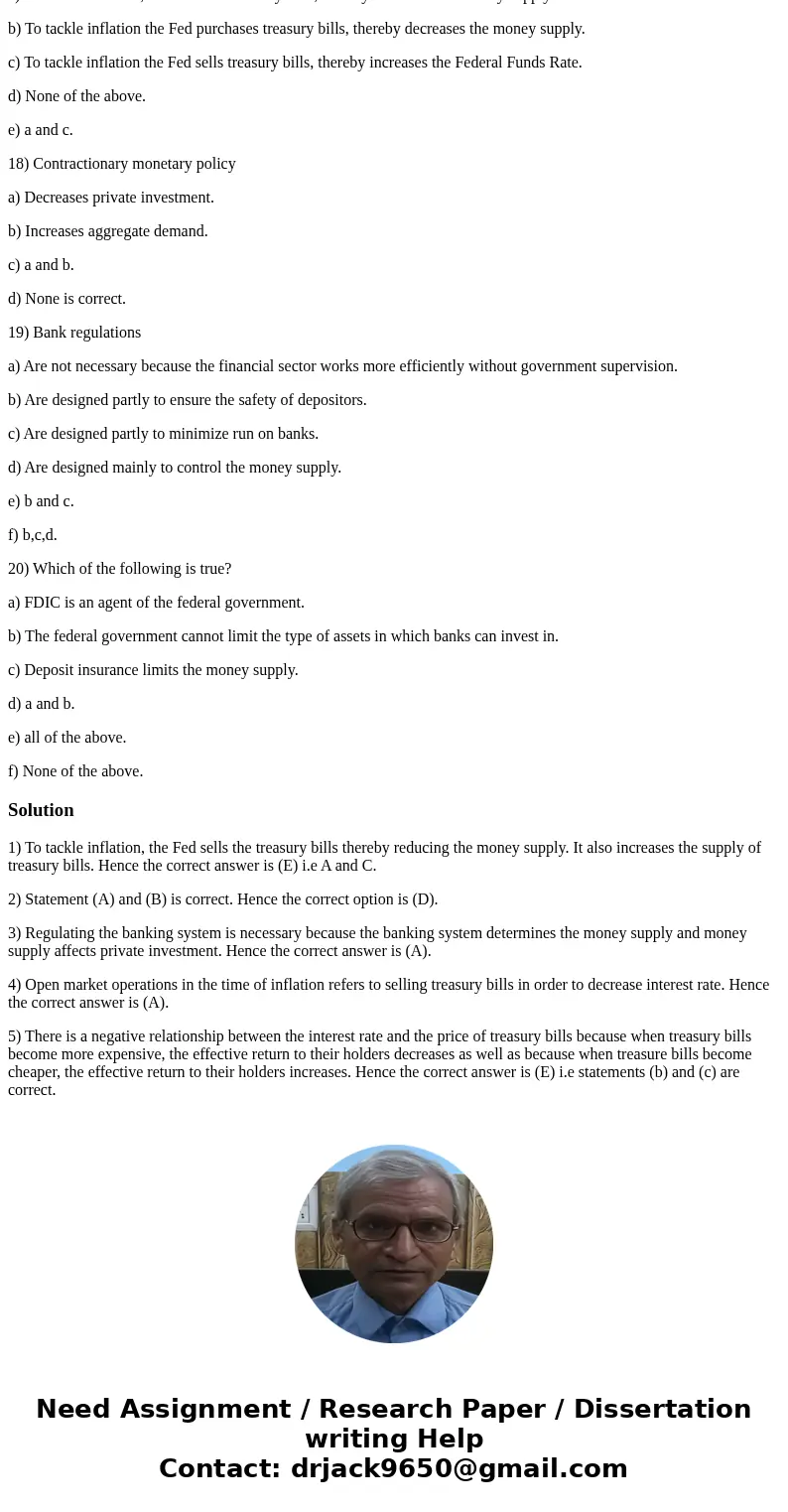1 Which of the following is true a To tackle inflation the F
1) Which of the following is true?
a) To tackle inflation, the Fed sells treasury bills, thereby decreases the money supply.
b) To tackle inflation the Fed purchases treasury bills, thereby decreases the money supply.
c) To tackle inflation the Fed sells treasury bills, thereby increases the supply of Treasury bills.
d) None of the above.
e) a and c.
2) Which of the following is true?
a) The negative relationship between the FFR and the price of treasury bills is a result of a change in the demand of treasury bills.
b) The price of treasury bills is likely to increase in the time of inflation because the Fed increases the demand of treasury bills.
c) The price of treasury bills is likely to decrease in the time of inflation as a result of an increase in the supply of treasury bills.
d) a and b.
e) a and c.
3) Regulating the banking system is necessary
a) Because the banking system determines the money supply and money supply affects private investment.
b) To make sure that fiscal policy is not influenced mainly by profit minded banks.
c) b and a.
d) None of the above.
4) Open market operations in the time of inflation
a) Refers to selling treasury bills in order to decrease interest rate.
b) Refers to buying treasury bills in order to increase money supply
c) Refers to buying treasury bills in order to decrease the interest rate.
d) Refers to selling treasury bills in order to decrease the supply of reserves.
e) None.
5) There is a negative relationship between the interest rate and the price of treasury bills because
a) When treasury bills become more expensive, the effective return to their holders increases.
b) When treasury bills become more expensive, the effective return to their holders decreases.
c) When treasury bills become cheaper, the effective return to their holders increases.
d) When treasury bills become cheaper, the effective return to their holders decreases.
e) b and c.
6) Which of the following is correct?
a) The Fed can precisely target the money supply but not the interest rate.
b) The Fed can precisely target the interest rate but not the money supply.
c) The Fed can precisely target the money supply but not the supply of reserves.
d) The Fed can precisely target the supply of reserves but not the money supply.
e) b and d.
7) Which of the following is correct?
a) The Fed can precisely target the money supply because it can exactly determine the money multiplier.
b) The Fed can precisely target the interest rate because it can exactly determine the money multiplier.
c) The Fed cannot precisely target the money supply because it cannot exactly determine the money multiplier.
d) The Fed cannot precisely target the supply of reserves because it cannot exactly determine the money multiplier.
e) c and d.
8) If the rate of required reserves is 0.1, then the money multiplier is approximately
a) 5
b) 4
c) 10
d) 0.1
9) If the rate of required reserves is 0.2, then
a) A 2 percent increase in the interest rate increases the money supply by 4 percent.
b) A 2 percent increase in the interest rate decreases the money supply by 4 percent.
c) A 1 dollar increase in the reserves increases the money supply by 5 dollars.
d) A 1 dollar increase in the money supply increases the reserves by 5 dollars.
10) Which of the following is NOT an example of expansionary monetary policy?
a) A reduction in the rate of required reserves.
b) Buying treasury bills.
c) Lending to banks.
d) Decreasing the interest rate.
e) All are examples of expansionary monetary policy.
11) Which of the following is an example of contractionary monetary policy?
a) Increasing capital gains taxes.
b) Decreasing the budget for national defense.
c) Buying treasury bills.
d) a and b.
e) None of the above.
12) The money multiplier
a) Cannot be precisely determined because private banks may choose to keep more reserves than what is mandatory by the rate of required reserves.
b) Cannot be precisely determined because private banks may choose to keep less reserves than what is mandatory by the rate of required reserves.
c) Can be precisely determined because the Fed can precisely target the interest rate.
d) None of the above.
13) Which of the following is an example of contractionary monetary policy?
a) An increase in the rate of required reserves.
b) Buying treasury bills.
c) Selling treasury bills.
d) a, c.
e) a, b.
14) Which of the following is true?
a) To tackle recession, the Fed buys treasury bills, thereby increases the money supply.
b) To tackle recession the Fed purchases treasury bills, thereby increases the reserves.
c) To tackle inflation the Fed buys treasury bills, thereby decreases the interest rate.
d) a and b.
e) a, b, c.
15) Which of the following is true?
a) The money multiplier is easily calculated by the Fed.
b) Monetary policy is usually not successful because the government cannot control its expenditures.
c) Monetary policy can no longer fix the economy because the Fed cannot precisely calculate the money multiplier.
d) None of the above.
16) Expansionary monetary policy
a) Decreases private investment.
b) Increases aggregate demand.
c) a and b.
d) None is correct.
17) Which of the following is true?
a) To tackle inflation, the Fed sells treasury bills, thereby decreases the money supply.
b) To tackle inflation the Fed purchases treasury bills, thereby decreases the money supply.
c) To tackle inflation the Fed sells treasury bills, thereby increases the Federal Funds Rate.
d) None of the above.
e) a and c.
18) Contractionary monetary policy
a) Decreases private investment.
b) Increases aggregate demand.
c) a and b.
d) None is correct.
19) Bank regulations
a) Are not necessary because the financial sector works more efficiently without government supervision.
b) Are designed partly to ensure the safety of depositors.
c) Are designed partly to minimize run on banks.
d) Are designed mainly to control the money supply.
e) b and c.
f) b,c,d.
20) Which of the following is true?
a) FDIC is an agent of the federal government.
b) The federal government cannot limit the type of assets in which banks can invest in.
c) Deposit insurance limits the money supply.
d) a and b.
e) all of the above.
f) None of the above.
Solution
1) To tackle inflation, the Fed sells the treasury bills thereby reducing the money supply. It also increases the supply of treasury bills. Hence the correct answer is (E) i.e A and C.
2) Statement (A) and (B) is correct. Hence the correct option is (D).
3) Regulating the banking system is necessary because the banking system determines the money supply and money supply affects private investment. Hence the correct answer is (A).
4) Open market operations in the time of inflation refers to selling treasury bills in order to decrease interest rate. Hence the correct answer is (A).
5) There is a negative relationship between the interest rate and the price of treasury bills because when treasury bills become more expensive, the effective return to their holders decreases as well as because when treasure bills become cheaper, the effective return to their holders increases. Hence the correct answer is (E) i.e statements (b) and (c) are correct.




 Homework Sourse
Homework Sourse